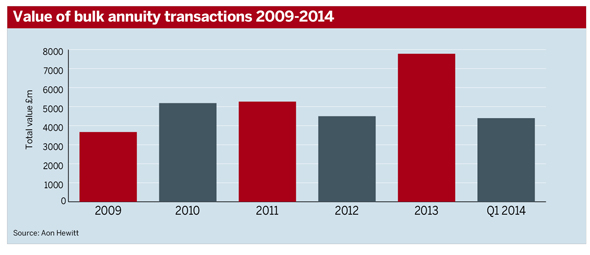The amount of scheme liabilities underwritten by insurers is expected to reach a record high this year as buy-ins become more affordable and scheme confidence grows, derisking consultants have said.
Schemes have shown increased interest over the past year in completing buy-ins and buyouts of their liabilities, to hedge against longevity risk and market volatility, industry figures have said.
French oil company Total announced last week it had insured £1.6bn of its UK pensioner liabilities with Pension Insurance Corporation – the second-largest bulk annuity transaction to date.
Ben Stone, risk transaction specialist at consultancy PwC, said he predicts more than £10bn of scheme liabilities will be insured this year, exceeding the £7.8bn of buy-ins and buyouts in 2013 (see graph).

“Affordability for pension schemes [is a factor] because over the last year the equity markets have done quite well, [which] could mean that schemes are in a better funded position, particularly [for] the ones that are closer to full buyout,” said Stone.
Schemes have also been more drawn to undertaking buy-ins and buyouts due to a more realistic assessment of the transaction process, Stone said.
“That often includes some [degree] of prudence and so doesn’t fully take into account competitive tension when you go into some of these processes,” he said.
Insurers have also shown more interest in underwriting a greater amount of liabilities, consultants said.
The greater flexibility given to members of defined contribution schemes in this year’s Budget has also been named by some as a reason for annuity providers offering more competitive bulk annuity pricing.
“They would have been relying on a regular stream of income of people buying individual annuities,” said Stone.
However Matt Wilmington, partner at consultancy Aon Hewitt, said the decrease anticipated in the number of members buying annuities could instead lead to more insurers that sell individual annuities launching in the bulk transaction market and providing better value for schemes looking to derisk.
Friends Life, which provides individual annuities, said it is currently considering entering the bulk annuity market.
Getting the best price
Some consultants advised schemes to carry out a data cleansing exercise when entering a buy-in or buyout.
“If it’s complete and accurate then it requires you to make [fewer] assumptions about the bits that are missing,” said Stone.
However, Tom Ground, head of bulk annuties at insurer Legal & General, said a scheme in a position to move quickly and take advantage of the best possible market timing can reduce pricing by up to 10 per cent.
“Getting the best market timing can be better than going on the most clean data but doing it really slowly,” he said.
Thinking about the benefits structure they want to hedge is also important for schemes, consultants said.
Capping inflation by carrying out a pension increase exchange or changing the benefits structure can be one way to lower prices, they added.
Ground agreed Pies can help schemes secure a better deal with insurers.
“There’s no really easy way of pricing [consumer price index] and most insurers will take some risk on, but it’s hard to push it on [at] the other end,” said Ground.
Schemes can also look at the way different insurers are pricing liabilities and review the population of their own members, said Wilmington.
“Some of the medical annuity providers – you might look to them to do a transaction carrying some of the very high earners and look to a traditional insurer for some of the rest of the population,” he said.














